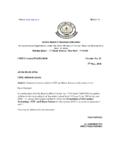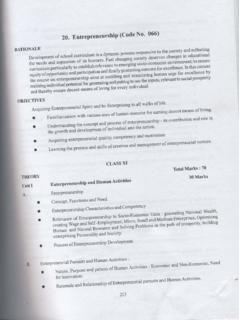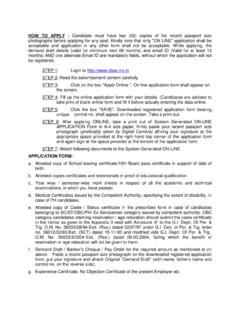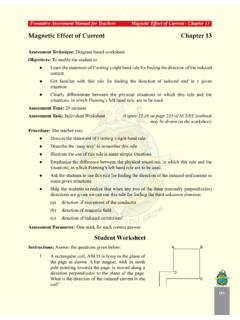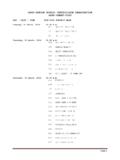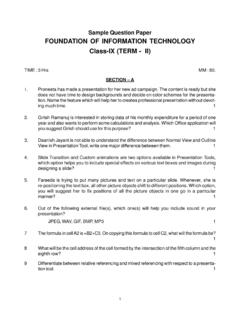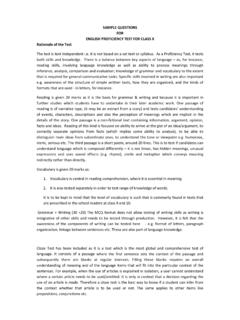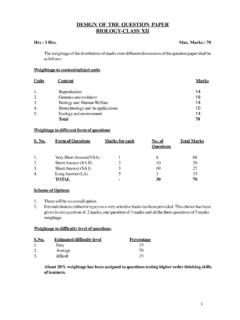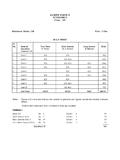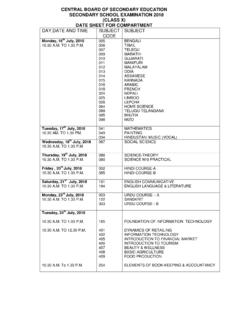Transcription of Chapter 8 Operations of Depository Participants - CBSE
1 cbse introduction to financial Markets - II113 Chapter 8 Operations of Depository ParticipantsLearning Objectives:After reading this Chapter , you should be understand meaning and importance of understand the importance of dematerialization of securities and theprocess understand the process of transfer of apply the knowledge in real life guide engine to Depository Securities Identification that can be of of having a demat and Settlement of dematted of transfer of of off-market of Market introduction Depository SystemThe earlier settlement system on Indian stock exchanges was very inefficient as it wasunable to take care of the transfer of securities in a quick/speedy manner.
2 Since, thesecurities were in the form of physical certificates; their quick movement was againdifficult. This led to settlement delays, theft, forgery, mutilation and bad deliveriesand also to added wipeout these problems, the Depositories Act 1996 was passed. It was formed withthe purpose of ensuring free transferability of securities with speed, accuracy &security. It has been able to do so by:a)Making securities of public limited companies freely transferable, subject tocertain exceptions;b)Dematerialising the securities in the Depository mode; andc)Providing for maintenance of ownership records in a book entry performing the above tasks, two depositories viz,NSDL & CDSL have come introduction to financial Markets - II114 National Securities Depository Limited (NSDL) does the above tasks for the tradesdone on NSE.
3 It is a joint venture of: IDBI (Industrial Development Bank of India Limited); NSE (National Stock Exchange); and UTI (Unit Trust of India).NSDL is the first Depository to be set up in India. It was registered by SEBI on June 7, second depositoryCentral Depository Services Limited (CDSL) has beenpromoted by Bombay Stock Exchange and Bank of India. It was formed in February1999. Both depositories have a network of Depository Participants (DPs) which arefurther electronically connected to their clients. So, DPs act as a link between thedepositories and the system to some extent works like thebanking system. There is acentral bank and the rules and regulations related to the working of all thecommercial, foreign, co-operative and other types of banks are framed by the centralbank.
4 In order to do the daily transactions, the investors open an account with theassociate banks, and not with the central one. Like an investor can have a bankaccount with more than one bank, similarly one can have more than one DematAccount. We can further bring out the similarities as well as the differences betweenthe two in understanding the Depository system. (See Table )Table : NSDL BANK: The SimilaritiesBANKNSDL Holds funds in accounts Transfers funds between accounts Transfers without handling cash Safekeeping of money Holds securities in accounts Transfers securities between accounts Transfers without handling physicalsecurities Safekeeping of securitiesTable : NSDL BANK.
5 The DifferencesBANKNSDL Either of holders can signinstructions Minimum balance to be maintained Entitled for interest Uses balances in accounts Nomination is kept confidential All joint holders to sign instructions No minimum balance required Interest can be earned only byparticipating in Stock Lending Scheme Does not move balances in accountwithout account holder s authorization Signature and photograph of nomineeto be providedAs a broker represents their investors, and can trade on their behalf either on thestock exchange or off-market. Similarly, a Depository participant (DP) is therepresentative (agent) of the investor in the Depository system providing the linkbetween the Company and the client through the Depository .
6 The client s DepositoryParticipant will maintain his securities account balances and intimate the status ofthe holding from time to time. According to SEBI guidelines, financial Institutionslike banks, custodians, stockbrokers etc. can become Participants in the Depository . ACBSE introduction to financial Markets - II115DP is one with whom a client needs to open an account to deal in electronic the Depository can be compared to a Bank, DP is like a branch of a bank withwhich one can have an account. Therefore, DPs are authorized to maintain accountsof dematerialized shares. They help in instantaneous electronic transfer of shares heldin Demat form throughelectronic book entry entry system is a system under which no physical transfer of securities takesplace.
7 In case of change of ownership rights, securities do not change handsphysically. To facilitate the change of name/ownership rights, merely a book entry ispassed. Since, the securities are fungible; transfer becomes meansthat all the holdings of a particular security are identical & inter-changeable & theyhave no unique characteristic such as distinctive number, certificate no., folio no. have a better understanding of the concept of fungibility, we can take an exampleof a currency note. Just as an note can be interchangeable with any othernote of , similarly securities of a company can be interchanged with any othersecurity of the same company, as the distinctive number of the security does securities are bought and sold, transfer of name has to take place.
8 Earlier,when the securities were in the physical form, it used to take a lot of time as it was acumbersome process. The physical securities were send to the R&TA (Registrar andTransfer Agents) appointed by the company along with the required form for change ofname/transfer of securities. The R&TA (Registrar and Transfer Agents) used to makethe due changes as required and send them back. This whole process was timeconsuming and sometimes the securities never reached its destination, thus creatinglot of inconvenience to the investors. To get away with such problems, securities werechanged into demat form which helped in quick transfer of securities and alsoeliminate the fear of theft, mutilation etc.
9 Apart from getting the current holdingschanged into demat form, one can also receive their shares in demat form whenoffered during an initial public issue by giving the appropriate instructions in theapplication itself. If one is adopting this approach, then he has to also furnish thedetails of his bank account number, name of the DP, DP ID and client ID to facilitatethe transfer of owner and Beneficiary ownerAll the public limited companies are required by the Companies Act 1956 to maintainan index of members, wherein they are required to keep a record or the owners of thecompany. With the concept of dematerialization of securities and transfer of sharesthrough book entry system coming up, registered owners are NSDL and CDSL , in the index of members of any company, there are only two registered owners, two depositories.
10 The depositories keep a track of all the clients through thedepository Participants . Therefore,the registered owners are the depositorieswhereas the beneficiary owners are the people who are holding the securities atany given point of time. Whenever a company declares a bonus issue, the securitiesare transferred in the name of the two depositories and they further transfer it to theclients through their Participants . Therefore, the depositories are known as theregistered owners and the investors are known as the beneficiary owners as they getthe benefits of all the corporate introduction to financial Markets - II116 Further, if a company declares a cash dividend, then the details of the holdings by theinvestors is given by the respective Depository Participants to the Depository so thatthe details can further be given to theRTA (Registrar and Transfer Agents) whichwould facilitate them to directly transfer the amount to the bank account of theinvestor/holder through the ECS (Electronic Clearing System)
